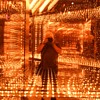Posted 12 years ago
 rniederman
rniederman
(346 items)
Cameras that made many pictures on a single plate (multiplying cameras) came in many different forms. By the first decade of the 20th century, a great transition was taking place and a battle for technical supremacy was just about finished. Small, portable film cameras were quickly replacing heavier folding wood plate cameras. For example, Kodak's 1912 consumer catalogue lists 22 roll film cameras!
Although glass plate photography would continue to enjoy a niche with photo-journalists well into the 1900s, one of the final nails in the dry plate coffin would come from a little known designer by the name of Oscar Barnack. In 1913, he would perfect a protoype 35mm film camera that evolved into the famous Leica series.
This is an extremely rare camera of which I know of only three examples (including mine). Instead of using multiple lenses or a shifting back, a tambour wood slide (same as what is used by roll-top desks) shifts the lens side-to-side to four different positions. In total, eight 1-3/4" x 2-1/2" images on a single 5" x 7" plate could be made. Compared to traditional multiplying view cameras such as the 4- and 9-tube studio cameras I posted, it is significantly smaller and portable.
Was the introduction of the Montauk Flexo-Front this late in the game an "anochronistic last-of-an-era design created to stave off the onslaught of roll film" (as summed up by a well known collector), or did Gennert see a market for a portable multiplying plate camera?
Whether or not Gennert truly understood the direction of the market, the camera was a bold idea and gamble that did not pay off. Yet it is historically interesting as [probably] the last commercially sold multiplying plate camera; a fine representative of a photographic style that was never seen again.



















Thanks musikchoo, BELLIN, miKK0, eric, officialfuel, and trunkman!
Thanks, gearpunk! BTW ... I think you'll find this interesting ... Mounted on the camera is a shutter designed specifically for landscape photography; it is called "Skyshade.” The shutter is somewhat rare and has an exotic drive train. It was designed to solve a classic landscape photography problem in which blue sensitive plates of the time had a tendency to overexpose the sky. To overcome this, the builder (Wollensak) designed the shutter blades to change speeds during exposure. At one part of the shutter cycle, the blades move fast to reduce the exposure of a bright sky. At the end of the shutter cycle, the blades slow down to give land below the horizon more exposure time. Normal shutters have blades that move at a constant speed. I'm unsure if the shutter was sturdy or worked well because this is the only example I've seen. If you’re curious, the Skyshade patent # is 831,256.
Thanks, Phil!
Thanks, Sean and f64imager!
Thanks, Perry!
Skyshade patent # is 831,256. very cool ............
Thanks, Windwalker ... and yes, the Skyshade shutter is very cool in operation.
Thanks, lee120275!